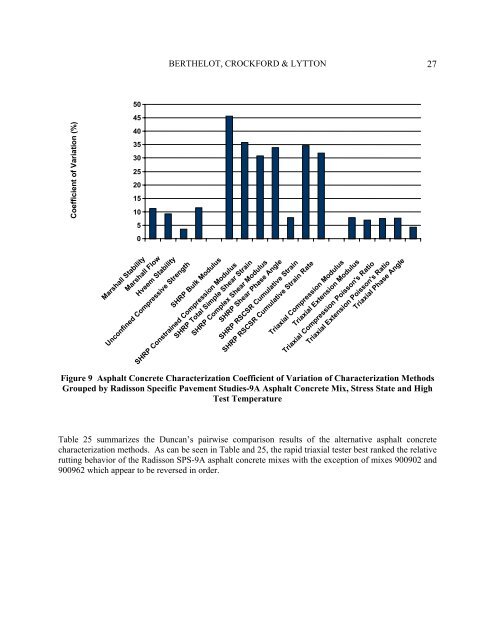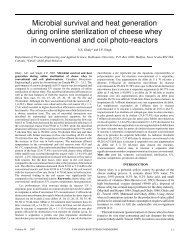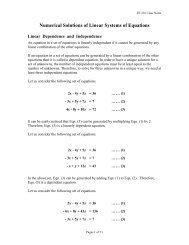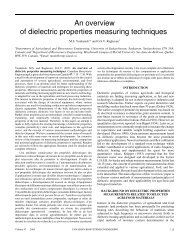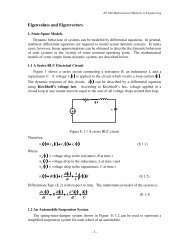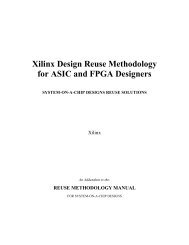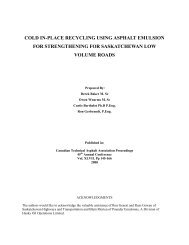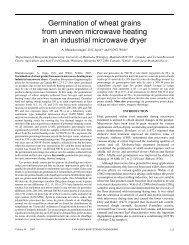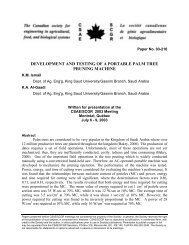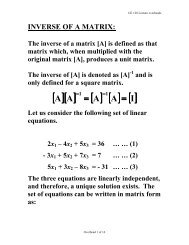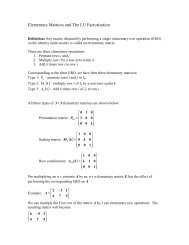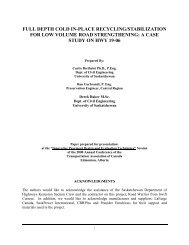BERTHELOT, CROCKFORD & LYTTON 2750Coefficient <strong>of</strong> Variation (%)454035302520151050Marshall StabilityMarshall FlowHveem StabilityUnconfined Compressive StrengthSHRP Bulk ModulusSHRP Total Simple Shear StrainSHRP Complex Shear ModulusSHRP Shear Phase AngleSHRP Constrained Compression ModulusSHRP RSCSR Cumulative StrainSHRP RSCSR Cumulative Strain RateTriaxial Compression ModulusTriaxial Extension ModulusTriaxial Compression Poisson's RatioTriaxial Extension Poisson's RatioTriaxial Phase AngleFigure 9 Asphalt Concrete Characterization Coefficient <strong>of</strong> Variation <strong>of</strong> Characterization MethodsGrouped by Radisson Specific Pavement Studies-9A Asphalt Concrete Mix, Stress State and HighTest TemperatureTable 25 summarizes the Duncan’s pairwise <strong>comparison</strong> results <strong>of</strong> the <strong>alternative</strong> <strong>asphalt</strong> <strong>concrete</strong><strong>characterization</strong> methods. As can be seen in Table and 25, the rapid triaxial tester best ranked the relative<strong>rut</strong>ting behavior <strong>of</strong> the Radisson SPS-9A <strong>asphalt</strong> <strong>concrete</strong> mixes with the exception <strong>of</strong> mixes 900902 and900962 which appear to be reversed in order.
BERTHELOT, CROCKFORD & LYTTON 28Table 25 Characterization Method Duncan's Pairwise Comparison <strong>of</strong> Radisson Specific PavementStudies -9A Asphalt Concrete MixesRANKING [Duncan's Pairwise Comparison]MIX PROPERTIES 1 2 3 4 5 6 7Marshall Stability 900901[C]900961[C]900903[B,C]900960[B]900959[A]900902[A]900962[A]Marshall Flow 900901[C]900961[C]900902[B,C]900903[B,C]900960[B,C]900959[A,B]900962[A]Hveem Stability 900901[D]Unconfined Compressive Strength 900962[D]SHRP Bulk Modulus 900961[C]SHRP Constrained Modulus 900901[C]SHRP Total Simple Shear Strain 900902[D]SHRP Complex Shear Modulus at 10Hz900961[B]SHRP Shear Phase Angle at 10 Hz 900902[B]SHRP RSCSR Shear Strain at 20000CyclesTriaxial Complex CompressionModulus at 10 Hz and SS3Triaxial Compression Poisson’s Ratioat 10 Hz and SS3Triaxial Phase Angle at 10 Hz andSS3Mean Field Rutting After ThreeYears Service {mm}900902[D]900962[E]900959[C]900959[F]900961{7.3}SHRP = Strategic Highway Research ProgramRSCSR = Repeated Shear at Constant Stress RatioSS3 = Stress State Three900961[C,D]900961[C]900959[B,C]900902[B,C]900959[C]900962[B]900962[B]900962[C,D]900961[D]900962[C]900902[E]900902{5.9}900959[C]900902[B,C]900901[A,B,C]900960[B,C]900962[C]900960[B]900959[A]900960[B,C,D]900960[D]900960[B]900903[D,E]900960{5.4}900903[C]900901[B,C]900962[A,B,C]900962[B,C]900960[B,C]900901[B]900901[A]900959[B,C,D]900902[C,D]900902[B]900962[D]900903{4.9}900960[B]900903[B,C]900903[A,B,C]900903[A,B]900901[B,C]900903[B]900960[A]900903[B,C]900903[C]900903[B]900960[C]900901{4.3}900962[B]900960[B]900902[A,B]900959[A]900903[B]900959[B]900961[A]900901[B]900901[B]900901[A]900901[B]900959{3.5}900902[A]900959[A]900960[A]900961[A]900961[A]900902[A]900903[A]900961[A]900959[A]900961[A]900961[A]900962{3.4}6.0 SUMMARY AND CONCLUSIONSThis study sought to investigate <strong>alternative</strong> methods for characterizing the <strong>rut</strong>ting behavior <strong>of</strong> <strong>asphalt</strong><strong>concrete</strong> mixes that can be used for material specifications and road modeling Seven Specific PavementStudies-9A <strong>asphalt</strong> <strong>concrete</strong> mixes (two Marshall and five Superpave TM ) built at the Radisson SPS-9A testsite were characterized with respect to Marshall stability and flow, Hveem stability, unconfinedcompressive strength, SHRP Level III shear tester, and triaxial frequency sweep properties. Thecoefficient <strong>of</strong> variation <strong>of</strong> the traditional phenomenological and rapid triaxial <strong>characterization</strong> methodswas relatively low. However, the SHRP Level III shear <strong>characterization</strong> produced a relatively high
- Page 1: COMPARISON OF ALTERNATIVE TEST METH
- Page 5 and 6: BERTHELOT, CROCKFORD & LYTTON 44.0
- Page 7 and 8: BERTHELOT, CROCKFORD & LYTTON 6not
- Page 9 and 10: BERTHELOT, CROCKFORD & LYTTON 8unco
- Page 11 and 12: BERTHELOT, CROCKFORD & LYTTON 10no
- Page 13 and 14: BERTHELOT, CROCKFORD & LYTTON 124.4
- Page 15 and 16: BERTHELOT, CROCKFORD & LYTTON 14Tab
- Page 17 and 18: BERTHELOT, CROCKFORD & LYTTON 16Tab
- Page 19 and 20: BERTHELOT, CROCKFORD & LYTTON 18Fig
- Page 21 and 22: BERTHELOT, CROCKFORD & LYTTON 20For
- Page 23 and 24: BERTHELOT, CROCKFORD & LYTTON 22Tab
- Page 25 and 26: BERTHELOT, CROCKFORD & LYTTON 24Tab
- Page 27: BERTHELOT, CROCKFORD & LYTTON 2650C
- Page 31 and 32: BERTHELOT, CROCKFORD & LYTTON 307.


